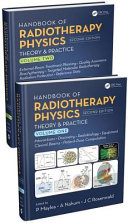

Most ebook files are in PDF format, so you can easily read them using various software such as Foxit Reader or directly on the Google Chrome browser.
Some ebook files are released by publishers in other formats such as .awz, .mobi, .epub, .fb2, etc. You may need to install specific software to read these formats on mobile/PC, such as Calibre.
Please read the tutorial at this link: https://ebookbell.com/faq
We offer FREE conversion to the popular formats you request; however, this may take some time. Therefore, right after payment, please email us, and we will try to provide the service as quickly as possible.
For some exceptional file formats or broken links (if any), please refrain from opening any disputes. Instead, email us first, and we will try to assist within a maximum of 6 hours.
EbookBell Team

4.4
42 reviewsFrom the essential background physics and radiobiology to the latest imaging and treatment modalities, the updated second edition of Handbook of Radiotherapy Physics: Theory & Practice covers all aspects of the subject.
In Volume 1, Part A includes the Interaction of Radiation with Matter (charged particles and photons) and the Fundamentals of Dosimetry with an extensive section on small-field physics. Part B covers Radiobiology with increased emphasis on hypofractionation. Part C describes Equipment for Imaging and Therapy including MR-guided linear accelerators. Part D on Dose Measurement includes chapters on ionisation chambers, solid-state detectors, film and gels, as well as a detailed description and explanation of Codes of Practice for Reference Dose Determination including detector correction factors in small fields. Part E describes the properties of Clinical (external) Beams. The various methods (or ‘algorithms’) for Computing Doses in Patients irradiated by photon, electron and proton beams are described in Part F with increased emphasis on Monte-Carlo-based and grid-based deterministic algorithms.
In Volume 2, Part G covers all aspects of Treatment Planning including CT-, MR- and Radionuclide-based patient imaging, Intensity-Modulated Photon Beams, Electron and Proton Beams, Stereotactic and Total Body Irradiation and the use of the dosimetric and radiobiological metrics TCP and NTCP for plan evaluation and optimisation. Quality Assurance fundamentals with application to equipment and processes are covered in Part H. Radionuclides, equipment and methods for Brachytherapy and Targeted Molecular Therapy are covered in Parts I and J, respectively. Finally, Part K is devoted to Radiation Protection of the public, staff and patients. Extensive tables of Physical Constants, Photon, Electron and Proton Interaction data, and typical Photon Beam and Radionuclide data are given in Part L.
Edited by recognised authorities in the field, with individual chapters wri